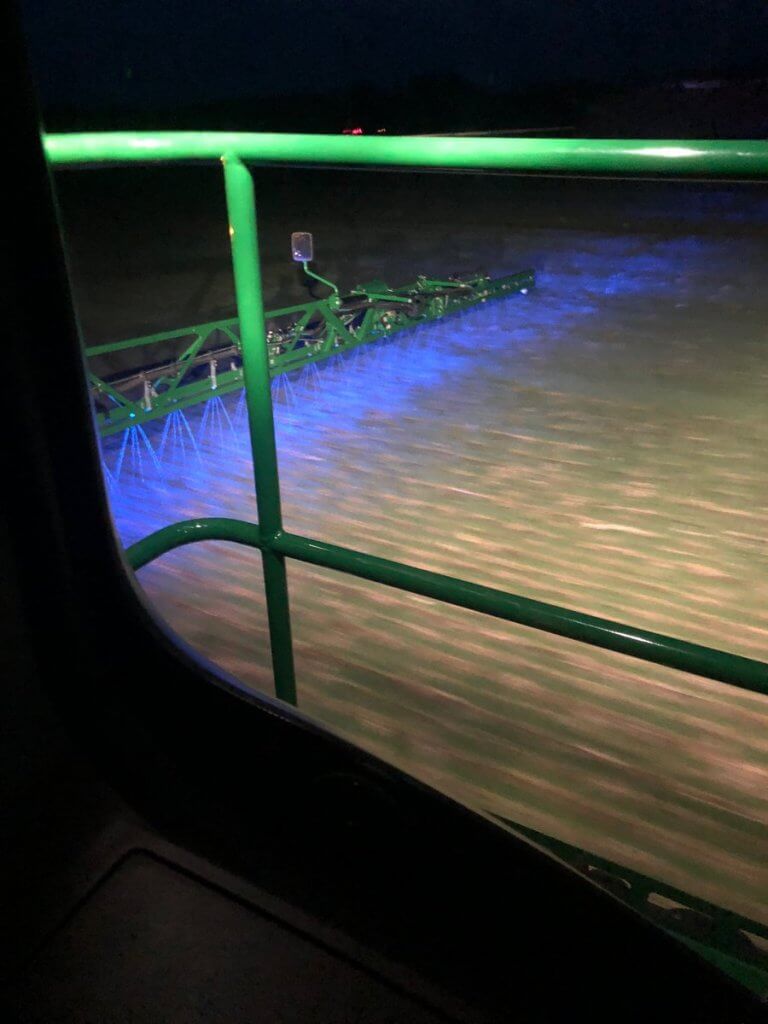With an ever growing selection of options for nozzles and streamer bars, many growers are asking the question, what should I outfit my sprayer with for winter wheat liquid fertilizer applications? Well, it depends on what are you trying to accomplish.
If the goal is to push your winter wheat management and improve yields, then the accurate and uniform application of liquid nitrogen is key. Selecting the appropriate sprayer technology can have a huge impact. Using a twitter poll, we learned that growers use many methods:
- 3, 5, 6 or 7 hole streamer nozzles
- Flood nozzles
- 3 or 5 hole streamer bars
Let’s look at some of the options and consider why you might choose one technology over another.

Air Induction, Conventional Flat Fan or Flood Nozzles
Let’s get this one out of the way first. Air induction (AI), conventional flat fan and flood nozzles are a no-go when it comes to applying 28% UAN in winter wheat. Dr. Peter Sikkema (University of Guelph) demonstrated that when 28% UAN was applied with an AI nozzle there was an increase in visual crop injury (Table 1).
He also showed that injury increased substantially when tank-mixed with herbicides and when nitrogen applications were delayed (Table 2). So, while AI nozzles are great for herbicide applications, they are not suitable for 28%. Growers should consider fall weed control to avoid the need for spring herbicide applications.
Table 1. Potential yield loss associated with applying UAN 28% as overall broadcast treatment using FloodJet or TeeJet nozzles. 11 gallon (Imperial) = 1.2 U.S gal. Source: P. Sikkema, University of Guelph (RCAT), 2008–2013 (OMAFRA Pub 811: Agronomy Guide).
| Application Combination | Visual Injury | Yield |
| 200 L/ha water (18 1g/ac water) | 0% | 6.4 t/ha (95 bu/ac) |
| 150 L/ha water + 50L/ha UAN (13.4 g/ac water +4.5 gal/acre UAN) | 3% | 6.4 t/ha (95 bu/ac) |
| 100 L/ha water + 100L/ha UAN (9 g/ac water +9 g/ac UAN) | 5% | 6.1 t/ha (91 bu/ac) |
| 50 L/ha water + 150L/ha UAN (4.5 g/ac water +13.4 g/ac UAN) | 7% | 6.1 t/ha (91 bu/ac) |
| 200 L/ha UAN (18 g/ac UAN) | 9% | 6.0 t/ha (89 bu/ac) |
Table 2. Crop injury (%) and yield (bu/ac) of winter wheat following an application of 28% UAN (400 L/ha) alone with air induction nozzles and with various herbicides compared to an untreated control that received the same amount of nitrogen. Source: Dr. P.H. Sikkema, 3 trials from 2008-2010, University of Guelph (Ridgetown Campus) – Additional information on tank-mixing with herbicides can be found here.
| Treatment | Herbicide rate/ac | Injury (%) | Yield (bu/ac) |
| control (unsprayed) | —— | 0 | 105 |
| 28% UAN alone | —— | 6 | 105 |
| 28% UAN + Infinity | 0.33 L | 9 | 104 |
| 28% UAN + Buctril M | 0.4 L | 8 | 103 |
| 28% UAN + Estaprop XT | 0.48 L | 9 | 102 |
| 28% UAN + Refine M | 12 g + 0.36 L | 17 | 99 |
Streamer Nozzles
Streamers significantly reduce crop injury when applying UAN 28% in winter wheat. Growers in Ontario are using a range of 3, 5, 6 and 7 hole nozzles. These nozzles provide even coverage and minimize burn compared to flat-fan or flood nozzles; however, boom height can have an impact on crop injury. This is particularly important with 3 and 6 hole streamer nozzles. If there are significant variations in boom height (e.g. uneven emergence, uneven land, or a boom with excessive sway and yaw), significant crop injury can occur. This is exacerbated by hot and dry conditions.
The damage is the result of non-uniform coverage. Streamers deliver spray in a triangular shape. If the boom is too low gaps in the spray pattern reduce coverage. If the boom is too high the crop may receive increased overlap, resulting in crop injury. Therefore, these nozzles are an excellent option for apply UAN 28% to winter wheat crop (see image below) as long as boom height can be managed effectively.
Pro tip: 28-0-0 often has crystals so strainers are important.

Streamer Bars
Streamer bars (see image below) may be the best choice. Streamer bars deliver liquid nitrogen to the crop vertically. This allows for even distribution across the winter wheat crop at various boom heights, often permitting great speed. Some even have a sliding orifice to permit an easy transition between rates. Research performed in Kentucky showed that streamer bars produced a 2.8 bu/ac yield advantage compared to 3 hole streamer nozzles, and a 4.9 bu/ac yield advantage over 7 hole streamer nozzles.
Some may argue those aren’t significant yield advantages, but most Ontario growers would argue differently. Streamer bars provide uniform coverage no matter the state of emergence, boom height, topography or even wind conditions. Streamer bars can be adapted to most sprayers and are available in 15″ or 20″ spacing. The only caveat is that they can be fragile and can make folding the boom difficult.

Other Ways to Reduce Burn
In addition to proper nozzle selection there are a few things you can do to reduce the risk of crop injury from N applications.
- Avoid applications of 28% when the crop is stressed or during hot and dry conditions.
- If conditions are more conducive for crop injury, increasing water volumes or applying less N can also help reduce burn significantly.
At the end of the day it is important to remember the end goal – maximize yield potential. If we can deliver UAN 28% as uniformly as possible to a standing winter wheat crop while minimizing crop injury, the 100+ bu/ac wheat crop will be well worth the effort.
Here’s Peter Johnson (@WheatPete) to tell you more in this RealAgriculture Wheat School episode:
Visitor Rating: 5 Stars
Visitor Rating: 4 Stars